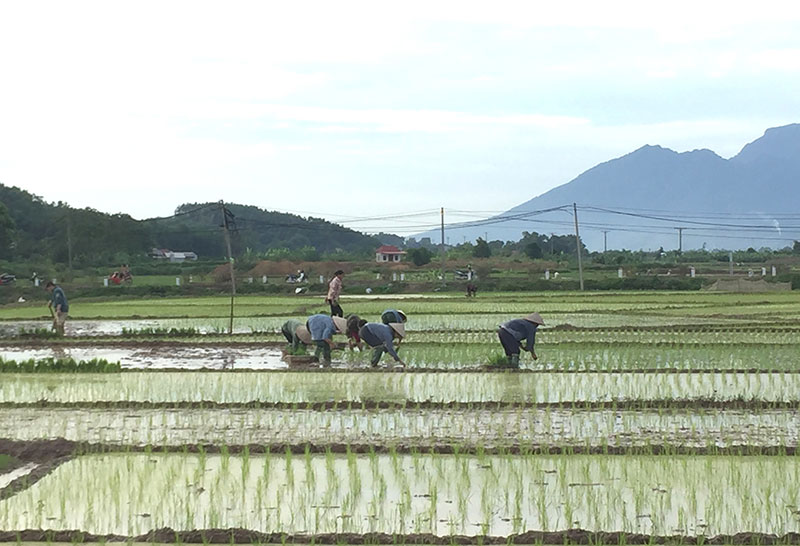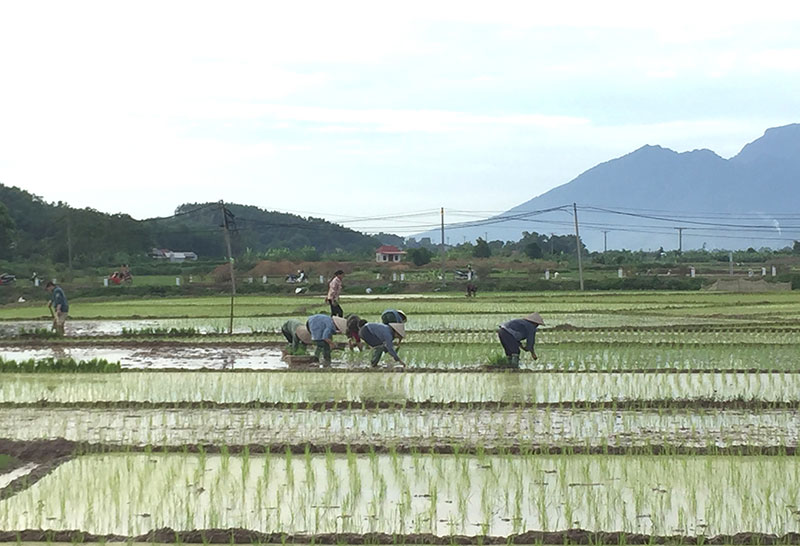
(HBO) – Following the bumper harvest of the 2019 spring crop, localities in Hoa Binh province have promptly prepared necessary conditions to begin the summer-autumn crop plan. By now, farming progress is being stepped up with a determination to plant almost all the major crops in July as scheduled.
 Thanks to favorable
water supply, farmers in Truong Yen hamlet, Yen Mong commune, Hoa Binh city, transplant
the remaining rice area of the season.
Thanks to favorable
water supply, farmers in Truong Yen hamlet, Yen Mong commune, Hoa Binh city, transplant
the remaining rice area of the season.
July is a proper time
as suggested by the provincial agriculture sector to begin this year’s rice crop.
As planned, the province will cultivate nearly 22,500ha of rice with an average
productivity of 5.100 tonnes per ha for the total output of 115,000 tonnes. Early
rice crop will account for nearly 15 – 20 percent of the total with major
varieties such as Thien uu 8, Nhi uu 838, MDDI, VS1, TH1, TH3-3, TH3-4, TBR225,
TBR36, TBR45, and Kim Cuong 111. Major crops will make up about 80 – 85 percent
with varieties of MD1, Thien uu 8, DDS1, TH3-3, TH3-4, Q5, Dai Duong 2, Phuc
Thai 168. Sowing began from June 10 – July 5, the first stage with seeds for
10-12 days, and the second for 12-15 days. The transplantation period will be
from July 10-20.
According to the provincial
Department of Agriculture and Rural Development, summer-autumn vegetable crops
are being grown to ensure the best harvest. As planned, the province will sow
nearly 13,400ha of maize, 1,700ha of sweet potato, 1,400ha of peanut, 4,300ha
of fruits and vegetables, over 1,000ha of spice, herbal and annual plants,
towards about 45,000ha each year.
In order to fulfill the
plan, the department urged the People’s Committees of districts and city to direct
production, devise specific plans in localities to ensure sufficient supply and
quality of varieties, fertiliser and agricultural materials for production. The
best season for maize is between June 5 and July 15 so that it is grown in many
areas, towards basically achieving cultivation area target in late August at
the latest.
According to data from the Hoa Binh Provincial Party Committee, the industrial production index for the first six months of 2025 is estimated to have increased by 20% compared to the same period last year. This marks the highest year-on-year growth rate for this period since 2020.
In the first six months of 2025, Hoa Binh province’s export turnover was estimated at 1.145 billion USD, marking an 18.11% increase compared to the same period in 2024. Import turnover was estimated at $ 804 million, a 17.15% increase, which helped the province maintain a positive trade balance.
The lives of the ethnic minority farmers in Tan Lac district have gradually improved thanks to the new directions in agricultural production. This is a testament to the collective strength fostered through the professional associations and groups implemented by various levels of the district’s Farmers’ Union.
With the motto the "product quality comes first,” after nearly one year of establishment and operation, Muong village’s Clean Food Agricultural and Commercial Cooperative, located in Cau Hamlet, Hung Son Commune (Kim Boi district), has launched reputable, high-quality agricultural products to the market that are well-received by consumers. The products such as Muong village’s pork sausage, salt-cured chicken, and salt-cured pork hocks have gradually carved out a place in the market and they are on the path to obtaining the OCOP certification.
In the past, the phrase "bumper harvest, rock-bottom prices" was a familiar refrain for Vietnamese farmers engaged in fragmented, small-scale agriculture. But today, a new spirit is emerging across rural areas of Hoa Binh province - one of collaboration, organisation, and collective economic models that provide a stable foundation for production.
Maintaining growing area codes and packing facility codes in accordance with regulations is a mandatory requirement for agricultural products to be eligible for export. Recently, the Department of Agriculture and Environment of Hoa Binh province has intensified technical supervision of designated farming areas and packing facilities to safeguard the "green passport" that enables its products to access international markets.



 Thanks to favorable
water supply, farmers in Truong Yen hamlet, Yen Mong commune, Hoa Binh city, transplant
the remaining rice area of the season.
Thanks to favorable
water supply, farmers in Truong Yen hamlet, Yen Mong commune, Hoa Binh city, transplant
the remaining rice area of the season.